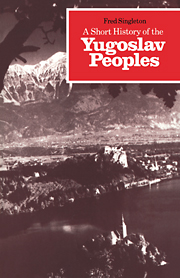Book contents
- Frontmatter
- Contents
- List of tables
- List of maps
- Preface
- Guide to pronunciation
- 1 The lands of the South Slavs
- 2 The early Slav settlers
- 3 The early Slav kingdoms
- 4 The South Slavs under foreign rule
- 5 The development of independence
- 6 The First World War
- 7 The kingdom of Serbs, Croats and Slovenes
- 8 The kingdom of Yugoslavia
- 9 Yugoslavia and the Second World War
- 10 The transition to socialism
- 11 The beginnings of self-management
- 12 The 1960s – a decade of reform
- 13 Tito's last ten years
- 14 Yugoslavia after Tito
- Bibliography
- Index
1 - The lands of the South Slavs
Published online by Cambridge University Press: 20 February 2010
- Frontmatter
- Contents
- List of tables
- List of maps
- Preface
- Guide to pronunciation
- 1 The lands of the South Slavs
- 2 The early Slav settlers
- 3 The early Slav kingdoms
- 4 The South Slavs under foreign rule
- 5 The development of independence
- 6 The First World War
- 7 The kingdom of Serbs, Croats and Slovenes
- 8 The kingdom of Yugoslavia
- 9 Yugoslavia and the Second World War
- 10 The transition to socialism
- 11 The beginnings of self-management
- 12 The 1960s – a decade of reform
- 13 Tito's last ten years
- 14 Yugoslavia after Tito
- Bibliography
- Index
Summary
The lands which the South Slav tribes first entered, in the middle of the first millennium AD, were geographically very different from their earlier homelands north of the Carpathians, in the Vistula basin and the Ukraine.
South-east Europe is a region of great geographical diversity, in which several major physiographic and climatic zones converge. The topography and drainage patterns suggest certain routes by which invaders have penetrated from all directions into the Balkan heartland. In the north, the Pannonian lowlands, drained by the Danube and its tributaries, the Drava and the Tisa, extend across the great Hungarian Alföld to the foothills of the Carpathians and to the southern entrance of the Moravian gate near Bratislava on the Danube. It is well established that the prehistoric amber trade, from Samland on the Baltic coast, used this route, and it was probably also used by German pastoralists and barbarian invaders.
The Danube itself provides an opening into Wallachia, via the Iron Gate at the south-eastern corner of the Pannonian plain. Trajan's arch at the entrance to the Gate commemorates the Roman conquest of Dacia in AD 102. The same passage, despite the narrow constriction of the valley at Djerdap, as the Danube forces its way between the Transylvanian Alps to the north and the Stara Planina to the south, may also have been a route for invaders into the Roman province of Pannonia, although the Iron Gate Pass, some 130 km (80 miles) further north, afforded a better route for the Goths who descended on Pannonia from Transylvania in the middle of the fourth century AD.
- Type
- Chapter
- Information
- A Short History of the Yugoslav Peoples , pp. 1 - 9Publisher: Cambridge University PressPrint publication year: 1985



